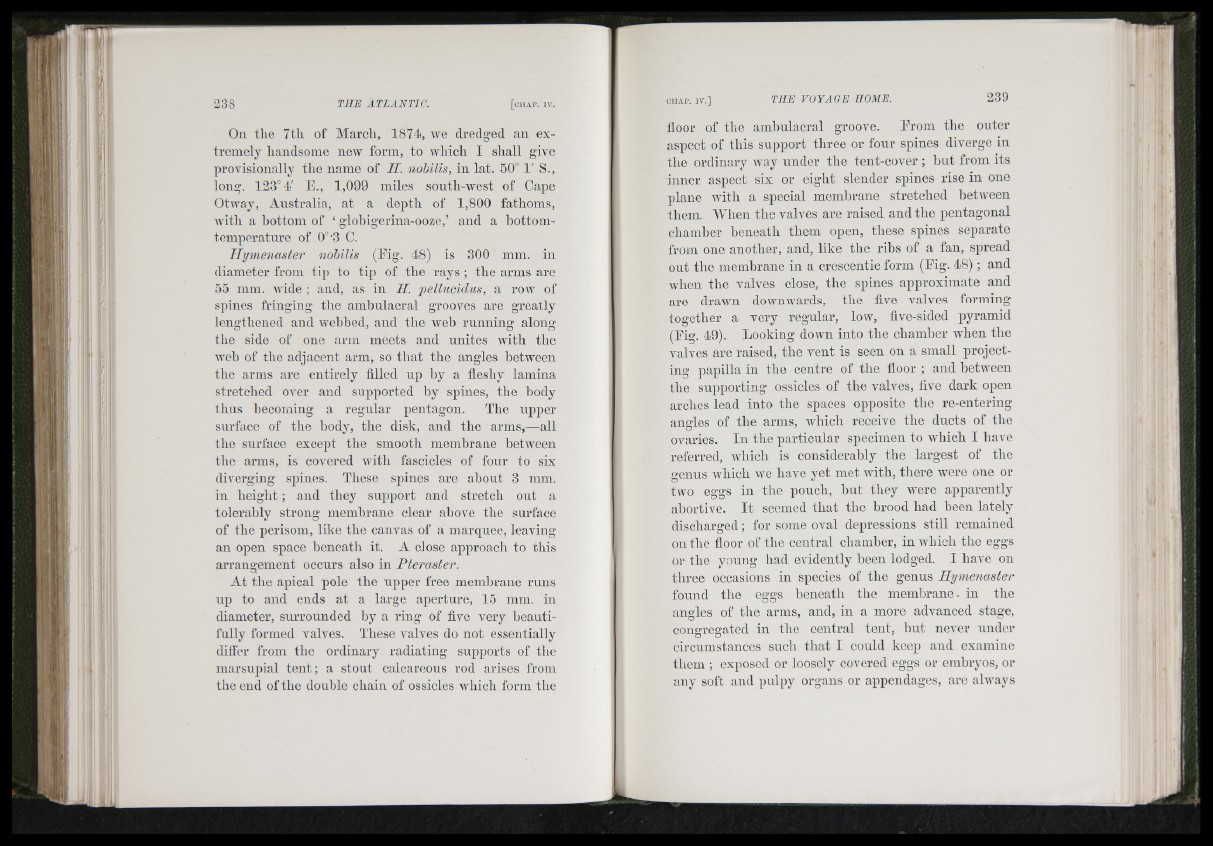
' il
i 'k : .
. ill
l i ; - I
Ii
On the 7tli of March, 1874, we dredged an extremely
handsome neAA' form, to which I shall give
provisionally the name of II. nobilis, in lat. 50° 1' S.,
long. 123° 4' E., 1,099 miles sonth-Avest of Cape
OtAA'ay, Anstraha, at a depth of 1,800 fathoms,
Avith a hottom of ‘ glohigerina-ooze,’ and a hottoni-
temperatnre of 0°'3 C.
Hymenaster nobilis (Eig. 48) is 300 mm. in
diameter from tip to tip of the rays ; the arms are
55 mm. Avide ; and, as in II. pellueidiis, a row of
spines fringing the amhnlacral grooves are greatly
lengthened and Avehhed, and the Aveh rnnning along
the side of one arm meets and unites with the
Aveh of the adjacent arm, so th a t the angles between
the arms are entirely filled np hy a fleshy lamina
stretched OA'er and supported by spines, the body
thus becomiug a regular pentagou. The upper
surface of the hody, the disk, aud the arms,—all
the surface except the smooth membrane hetAveeu
the arms, is covered Avith fascicles of four to six
diverging spines. These spines are about 3 mm.
in h e ig h t; aud they support and stretch out a
tolerably strong memhrane clear ahove the surface
of the perisom, like the canvas of a marquee, leaving
an open space beueath it. A close approach to this
arrangemeut occurs also in Pteraster.
At the apical pole the upper free memhrane runs
np to and ends at a large aperture, 15 mm. in
diameter, snrronuded hy a ring of five very heanti-
fnlly formed valves. These valves do not essentially
differ from the ordinary radiating supports of the
marsupial ten t; a stout calcareous rod arises from
the end of the double chain of ossicles which form tbe
floor of the amhulacral groove. Erom the outer
aspect of this support three or four spines diverge in
tbe ordinary Avay under the tent-cover ; b u t from its
inner aspect six or eight slender spines rise in one
plane Avitli a special membrane stretched betAveeu
them. When the valves arc raised and the pentagonal
chamber beneath them open, these spines separate
from one another, and, like the ribs of a fan, spread
out the membraue iu a crescentic form (Eig. 4 8 ); aud
when the valves close, the spines approximate aud
are drawn doAvnwards, tbe five valves forming
together a very regular, low, five-sided pyramid
(Eig. 49). Looking doAvn into the chamber when the
valves are raised, the vent is seen on a small projecting
papilla in the centre of the floor ; and between
the supporting ossicles of the valves, five dark open
arches lead into the spaces opposite the re-entering
angles of the arms, which receive the ducts of the
ovaries. In the particular specimen to Avhich I have
referred, Avhich is considerably the largest of the
genus Avhich avc have yet met AA'ith, there were one or
two eggs in the pouch, hnt they Avere apparently
abortive. I t seemed th at the brood had been lately
discharged; for some oval depressions still remained
on the floor of the central chamber, in Avhich the eggs
Ol- the yonng had evidently heen lodged. I have on
three occasions iu species of the genus Hymenaster
found the eggs beneath the membrane, in the
angles of the arms, and, in a more advanced stage,
congregated in tbe central tent, but never nnder
circnmstances sucli th at I could keep aud examine
them ; exposed or loosely covered eggs or embryos, or
any soft and pulpy organs or appendages, are always